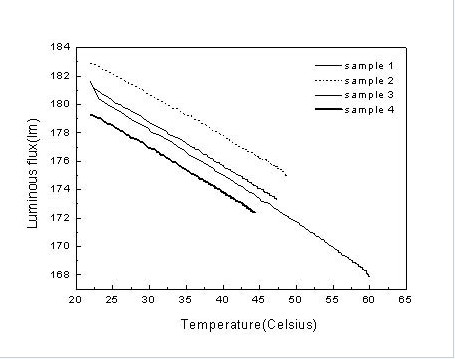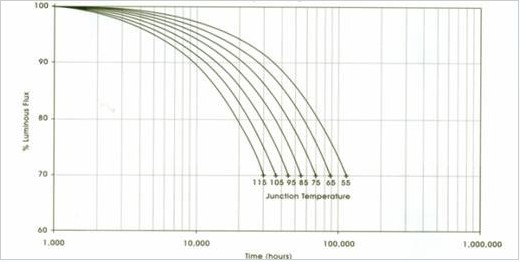
Privacy statement: Your privacy is very important to Us. Our company promises not to disclose your personal information to any external company with out your explicit permission.

I. Introduction
As the luminous flux of LEDs exceeds 100 lm/W, LEDs are increasingly valued as functional lighting, and many domestic and foreign manufacturers have studied LED luminaires. Although the effective luminous flux of LED road lighting fixtures gradually meets the requirements of road lighting, LED is a new type of lighting source, and many researchers need to conduct in-depth research.
Second, the related performance of LED lamps
This paper mainly elaborates and studies three aspects of LED lighting for road lighting: heat dissipation of lamps, light distribution of lamps and safety of lamps.
(1) Heat dissipation of lamps
Almost 20% of the energy of the LED chip is converted into light, and 80% of the energy is released in the form of heat. The voltage, luminous flux and luminous efficiency of the LED will decrease linearly with the increase of temperature, as shown in Figure 1, Figure 2. And Figure 3.

Figure 1 Curve of luminous flux with temperature

Figure 2 Voltage versus temperature curve

Figure 3 Curve of light effect with temperature
In addition, the heat dissipation effect of the luminaire will directly affect the service life of the luminaire, as shown in Figure 4.

Figure 4 Relationship between service life and junction temperature
Therefore, how to effectively dissipate heat is the key to the development of LED road lighting. It mainly involves four aspects: conduction (material heat transfer coefficient, applied temperature, etc.), convection (convection heat transfer coefficient and ambient fluid temperature, surface heat flux), and radiation (accelerated radiation). Materials), material properties (thermal stress strain analysis, thermal fatigue analysis, thermal induced structural failure analysis, etc.).
For conduction: 1, using rapid heat transfer materials such as heat pipes, copper, aluminum, etc.; 2, reduce the interface thermal resistance; for convection: 1, increase the contact area with air; 2, increase the heat capacity of the material; Increase convection and so on. For radiation: 1, using a new type of radiation material, can increase the radiation efficiency of the radiator below 100 degrees. For material properties: thermal stress strain analysis, thermal fatigue analysis, and thermal induced structural failure analysis are mainly considered. Considering the above factors, a reasonable lamp structure (double heat dissipation structure) can be designed, as shown in FIG.

Figure 5 luminaires with reasonable heat dissipation structure
The above luminaire design uses the heat pipe to quickly pump the heat of the LED module to the two sides of the luminaire through the back of the LED integrated module, and has a heat sink that can be ventilated up and down to dissipate heat thereof; another part of the heat can be dissipated by the heat sink behind the LED module.
(2) Light distribution of lamps
Due to the difference of roads, it is necessary to design lamps with different light distribution curves. It is not a kind of light distribution to meet different needs. However, the current application is more, and the larger the amount of use is the batwing type as shown in Fig. 6. Light distribution.

Figure 6 LED light distribution effect
(3) Safety performance of lamps
In addition to the general security features such as IP rating, EMI, EMC, and withstand voltage test, you should also consider the insecure factors in practical applications. This article mainly introduces three types:
Current LED road lamps often expose the LED heat sink directly to the air for good heat dissipation, as shown in Figure 7.

Figure 7 Common LED street light profile
For heat-dissipating structures exposed to the air, conditions such as dust, bird droppings, and acid rain are often encountered. During the long-term use, especially in the western part of China, a large amount of dust will continue to accumulate on the lamp housing. Although heavy rain can wash the lamp housing, the actual application found that the effect is not as good as we expected. For the lamps exported to foreign countries, a large number of birds directly facing the rest of the lamp shells, and even home problems, for bird droppings, almost no heavy rain can wash them, will directly affect the heat dissipation, life and beauty of the lamps. In addition, the current housing of the lamp is beautiful. Some companies use painting or coloring process, which affects heat dissipation. Under the acid rain, the lamp shell will appear rusty. In a large number of practical application summaries and continuous improvement and innovation, the luminaire shown in Fig. 8 can effectively avoid the above problems.


Figure 8 Schematic diagram of the structure of the street lamp
Third, the conclusion
LED lamps will gradually enter practical applications. For such a large market, quality will determine the final market share of LED-related companies.
The above content is provided by WOSEN. WOSEN is a professional manufacturer and supplier of Led Flood Light, Led Street Light, Led Solar Light, etc. For more information, please visit https://www.wosenled.com/ or contact admin@wosenled.com or WhatsApp +86-13425434349
Wyślij je do tym dostawcy

Privacy statement: Your privacy is very important to Us. Our company promises not to disclose your personal information to any external company with out your explicit permission.

Fill in more information so that we can get in touch with you faster
Privacy statement: Your privacy is very important to Us. Our company promises not to disclose your personal information to any external company with out your explicit permission.